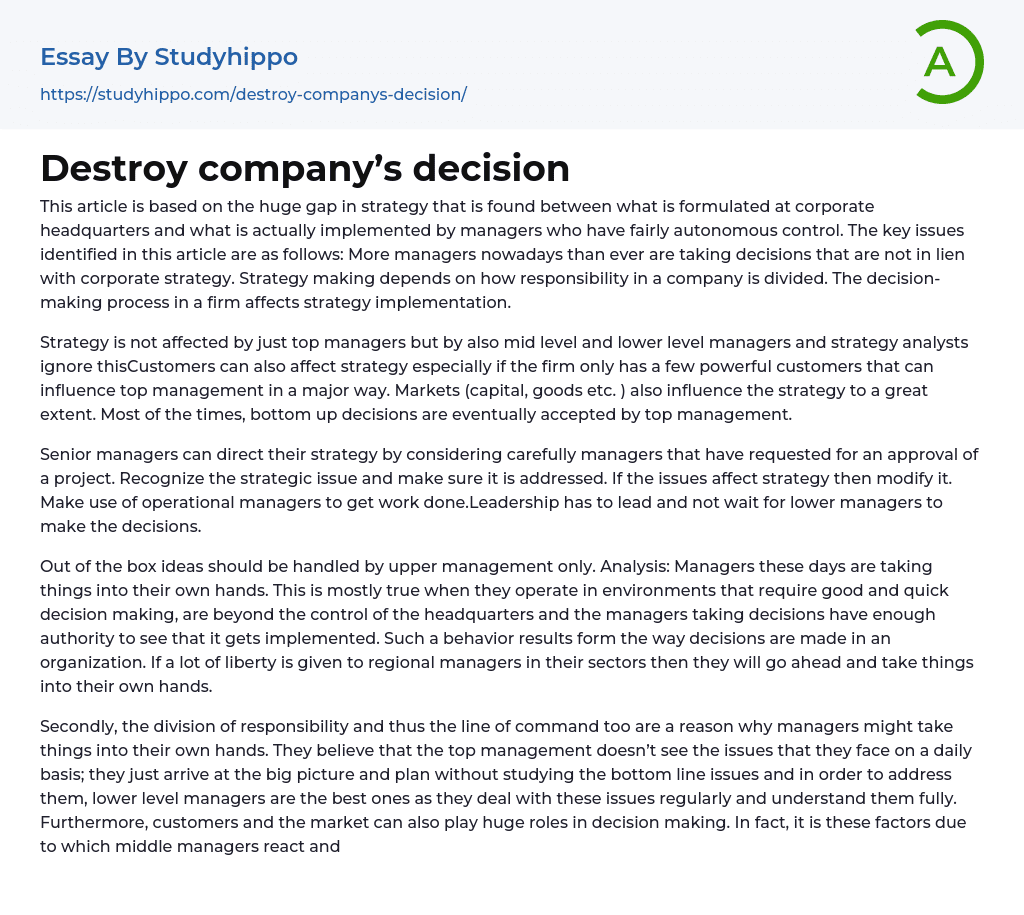This paper discusses the substantial disconnect between corporate headquarters' formulated strategies and their implementation by autonomous managers. It identifies key problems, such as managers making decisions that do not align with the overall strategy, responsibility distribution affecting strategic decision-making, and firm-level decision-making processes impacting successful implementation.
The influence of strategy extends beyond top-level managers. Mid and low-level managers as well as strategy analysts play important roles too. Moreover, powerful customers can greatly affect a firm's strategy if it relies heavily on them. Markets such as capital and goods markets also have a significant impact on the company's direction. Bottom-up decisions are often accepted by upper management in many cases.
Senior managers should carefully consider project requests made by managers and use them to direct their strategy. They must recognize strategic issu
...es and ensure they are addressed. If these issues affect strategy, the managers must modify it accordingly. Operational managers should be utilized to effectively execute the work. It is the responsibility of leadership to make decisions and not wait for lower managers to do so.
Upper management should be responsible for handling unconventional ideas. Analysis reveals that managers are increasingly taking matters into their own hands, especially in fast-paced environments where quick decisions are necessary and the decision-makers have the necessary authority to see them through. This behavior stems from how organizations make decisions; if regional managers are given considerable autonomy in their sectors, they may take matters into their own hands.
Managers may take matters into their own hands due to the division of responsibility and the corresponding line of command. They feel that top management does not recognize daily challenges and only focus on th
bigger picture, without considering bottom-line issues. Lower-level managers are better suited to address such problems, as they deal with them on a regular basis. Customer and market factors may also influence decision making for middle managers. However, top-level executives should not completely delegate decision making to lower-level managers. Success may be achieved through various control methods.
In order to approve bottom-up activities, managers should conduct background checks on involved managers and ensure they have a positive track record. Additionally, strategic issues should be considered and any potentially harmful actions should be altered to align with the strategy. All levels of management should be involved in formulating and implementing the strategy for smooth execution.
Leadership must recognize their role as leaders and not be passive observers. They need to take the lead and exercise caution when implementing risky ideas. Unconventional and innovative ideas are challenging to implement, requiring guidance from top management, as there is a higher risk of failure if solely approached from the bottom-up.
- Perseverance essays
- Expressive essays
- Character Traits essays
- Apology essays
- Compassion essays
- Bankruptcy essays
- Earnings essays
- Tata Group essays
- S corporation essays
- Secretary essays
- Premise essays
- Being A Leader essays
- Servant Leadership essays
- Leadership Experience essays
- Leadership Qualities essays
- Adult essays
- Aggression essays
- Altruism essays
- Archetype essays
- Behavior essays
- Certainty essays
- Conformity essays
- Deception essays
- Human Behavior essays
- Human Sexuality essays
- Maturity essays
- Morality essays
- Obedience essays
- Procrastination essays
- Reinforcement essays
- Role Model essays
- Adidas essays
- Amazon essays
- Apple essays
- Bmw essays
- British Airways essays
- Burger King essays
- Coca-Cola essays
- Company essays
- Costco essays
- Dell essays
- Ebay essays
- Enron essays
- Facebook essays
- Ford Motor Company essays
- Gap essays
- General Motors essays
- Google essays
- Honda essays
- Ibm essays




